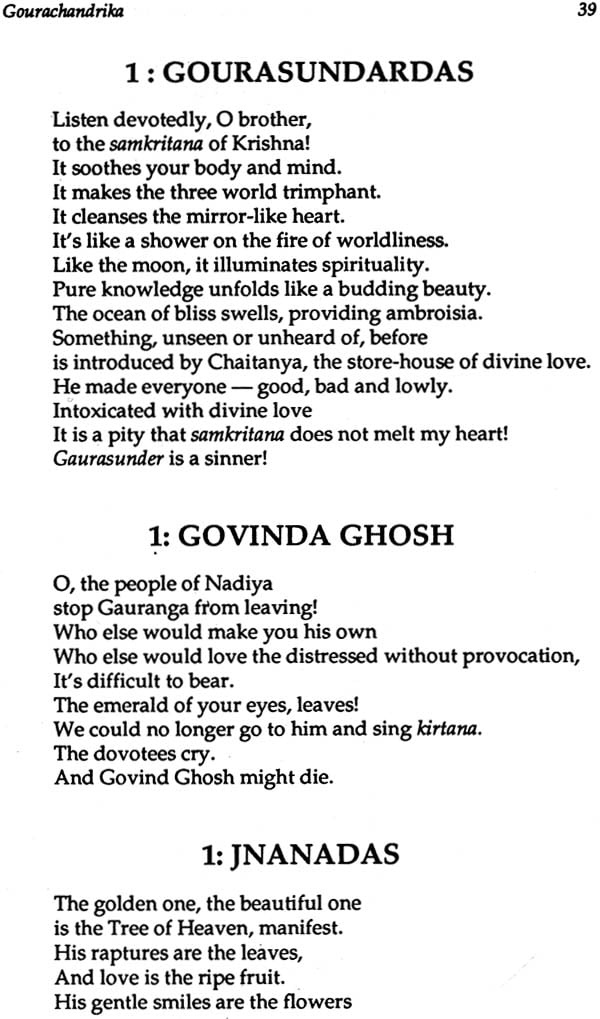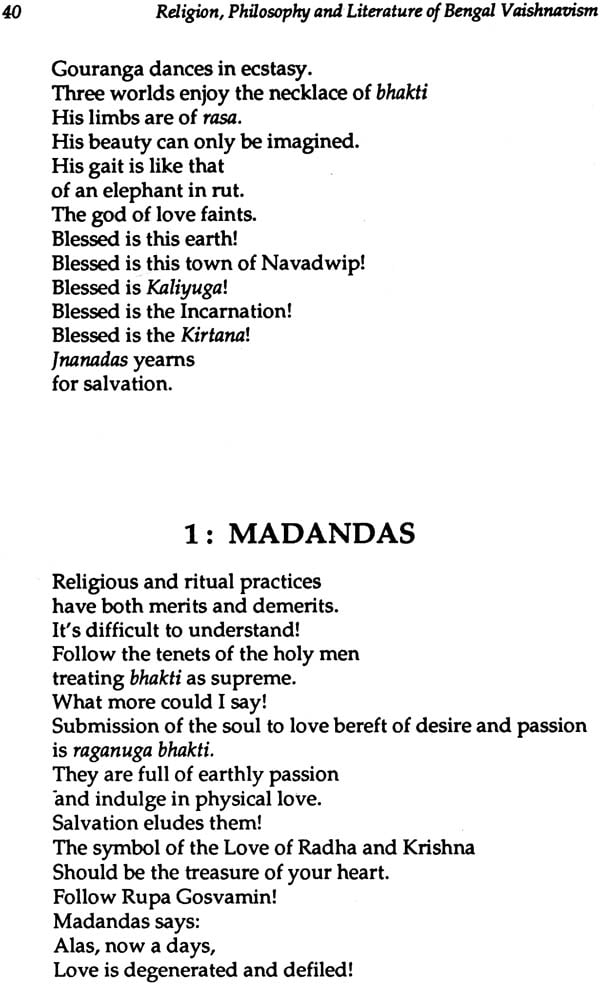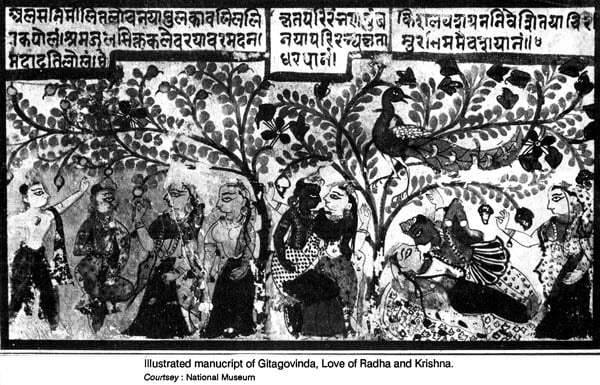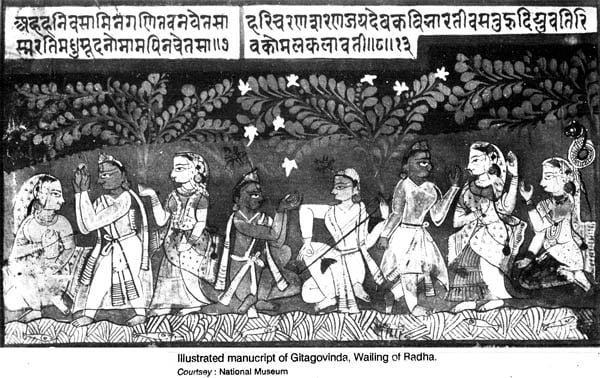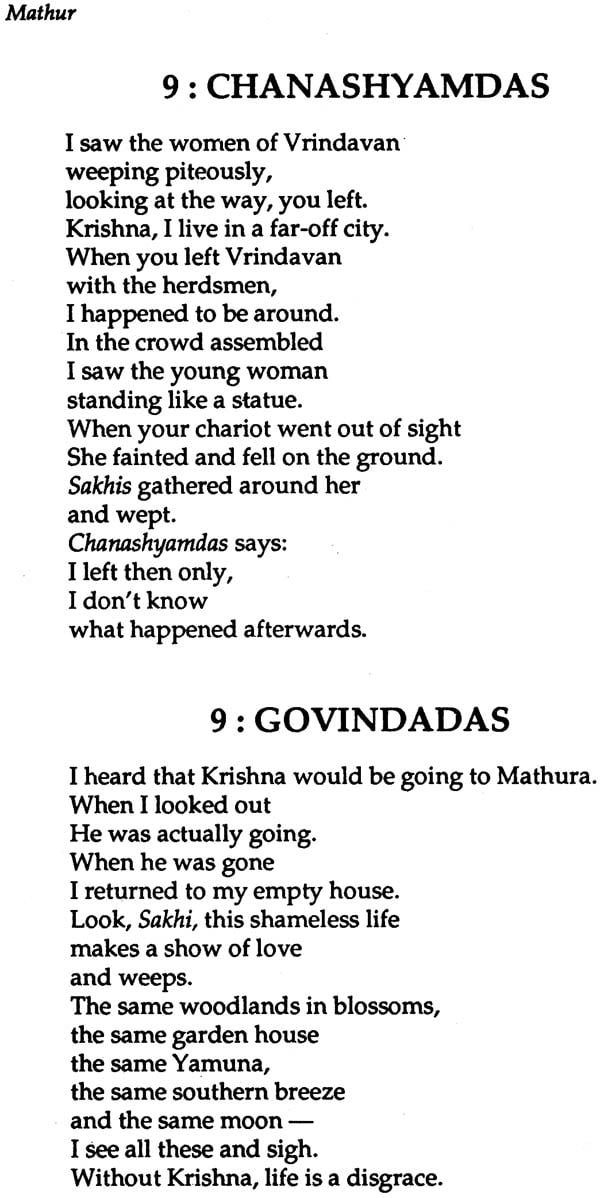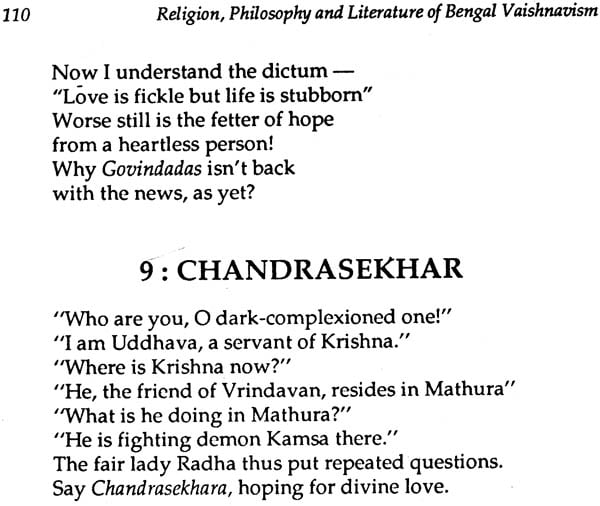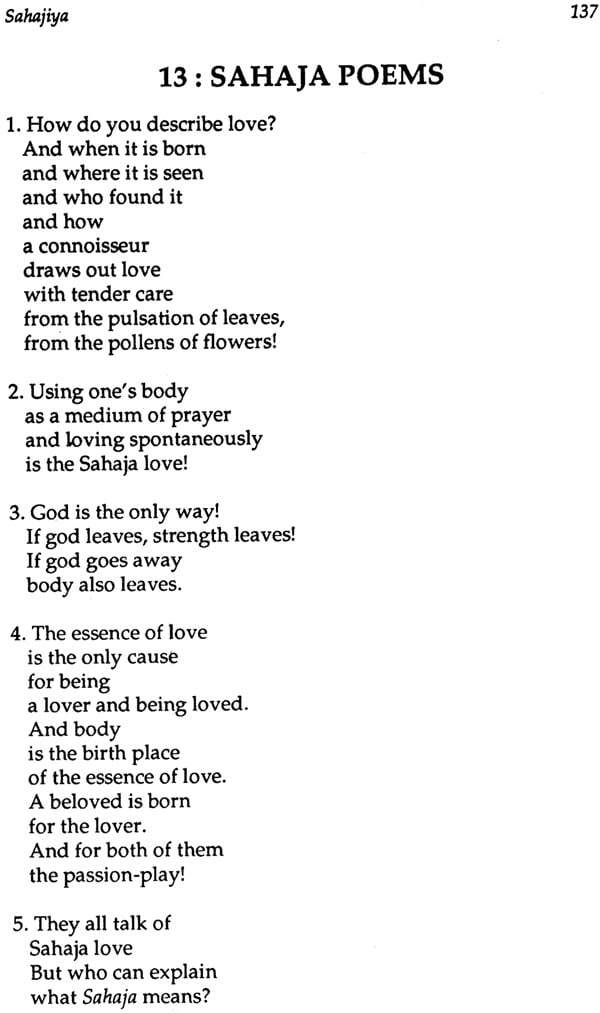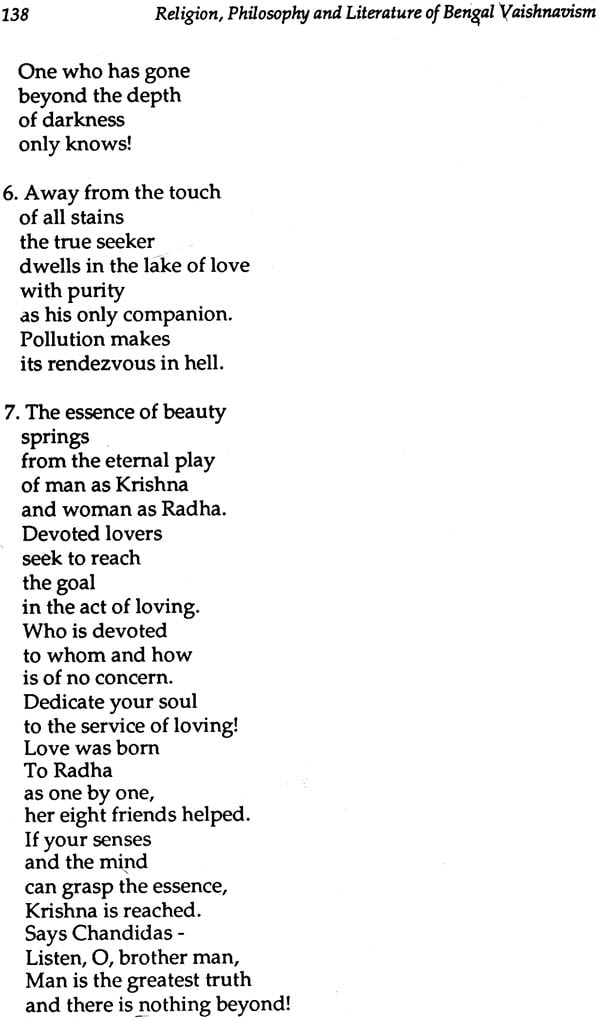
Religion, Philosophy and Literature of Bengal Vaishnavism (An Old and Rare Book)
Book Specification
| Item Code: | NAL321 |
| Author: | Durgadas Mukhopadhyaya |
| Publisher: | B.R. Publishing Corporation |
| Language: | English |
| Edition: | 1990 |
| Pages: | 163 |
| Cover: | Hardcover |
| Other Details | 8.5 inch X 5.5 inch |
| Weight | 350 gm |
Book Description
Religion, Philosophy and Literature of Bengal Vaishnavism is a significant work to offer a comprehensive analysis of Bengal Vaishnavism and translation o the rich literary treasure of erotic-mystic poetry written in a pan-Indian language Vrojobuli. The book presents understanding of the concept of bhakti as a rasa that criticize many conventional beliefs about the Radha Krishna theme and advance and alternative set of explanation and presentations which takes into account and contributes to, the latest studies in the fields of Indology, religion, literature, poetry and sociology. In its treatment of themes like bhakti movement, rasa system personalisation of god, the book not only fills a gap in secular studies of religious system in India but throws a new light on the understanding of Indian religious ethos in general, supplemented by a transparent translation of religio-mystic poetry in regional languages.
Durgadas Mukhopadhyay, who teaches in Delhi University is a scholar of performing arts, tribal culture and communication. He is the editor of Minimax, a journal of creative and critical writing. He produced nine educational and ethnographic films for Indian and foreign T.V. network. He was a contract Professor in University of Rome, Italy. He has lectured extensively abroad. His Ph.D. work is on Tribal Economy and Culture. He has organized 200 presentations of folk dance, music and theater in universities and institute for propagation of traditional culture. He has translated Natyashashtra Isapanishad and Vastushashtra into English. He has written books on puppet theaters and mask theater of India. He was the organizer of the session on “Anthropological Approaches to Traditional Perfotmance” of the Xth International Congress of Anthropological and Ethnological Science sessions of XIth World Sociological Conference.
He is the President of the international organisation SPARTA (Society for Promotion, Analysis and Research of Traditional Arts). He is a member of International Federation of Theater Research, SIBMAS, International Association of Theater Critics, International Sociological Association, International Commission for Visual Anthropology.
He is listed in well-known biographical publications e.g. Dictionary of International Biography, International Who’s Who in Poetry, Marquish Who’s Who.
In my childhood, I used to go for the kirtana recitals of the vaishnavas, singing, weeping with the singers, sharing their feelings without understanding the philosophy, mysticism or the erotic overtones. Through the years I grew up with the deep attachment with their concepts of prema, bhakti and rasa. During the period from the fourteenth to the seventeenth century a powerful bhakti movement swpet across northern and eastern India. The saints and mystic with their devotion to the personalized God wrote spiritual and mystical poetry. In Bengal, Chaitanya Preached the religion of love. Poets in Bengal created a rich literary treasure - - the Vaishnava Padavali.
Mysticism, the sense of unity I life is inseparable from the delight in all sensuous beauty. The keynote of Vaishnava Padavali is the sense of the manifestation of God in the daily and elemental realities of life.
In Bengal Vaishnavism, Radha is the soul while Krishna is God. Radha’s sexual passion symbolizes the soul’s intense longing for union with the infinite God. The love of Radha and Krishna is interpreted as a symbol of the soul’s union with God. As swami Vivekananda puts it, “The highest, most expressive, strongest and the most attractive human love is that between man and women and therefore that language was used in expressing the deepest devotion”.
Kritana is singing in group in praise of God. Gourachandrika is sung first to set the proper mood and to prevent any misinterpretation of the sensual imagery of the Radha Krishna songs which are to follow. Then they sing through the night: the boy Krishna playing in the field, the beauty of Radha, Krishna’s desire for her, the first shy and solemn meeting the lovers, their temporary separation and the ultimate union. In trance of spiritual ecstasy, they sing and dance through the night. The pique, the passion, the anger and the satisfaction, the separation and the union trace the course of true love between man and woman and between man and God. The spirit of getting lost in the quest of the unknown unknowable inspires existence. The religion of the Vaishnavas is ‘love’ – love which is spontaneous, love which knows no obstacle, love which longs for no reward, love which is universal. Love is their world, love is their life. Padavali is the manifestation of this universal mystic love. Padavali is like a bird, bhava is its body, rasa is its life force, words and melody are its two wings.
Bhakti is supreme love directed towards God. Two attributes of the personal God is aishvarya and madhurya. Aishvarya represents the majestic quality of the inconceivable, the immensity of His omnipotence. Madhurya refers to his loveable qualities. The devotee loves the god with Radha’s intense passion, Yashoda’s obcessive maternal affection, sudama’s devoted friendship for Krishna. Bhakti is the fusion of all these emotions and feelings and something more.
The painstaking probing into the philosophy, theology and the rasa system of Vaishnavaism to understand their poetry itself was a rich experience. The study of the stages of the blooming of love, the sixty-four rasa and sixty-four nayikas and so many profile of the manifestation of Radha- Krishna symbol was wonderful. I would love to share this experience with the readers.
I have arranged the poems in progression towards the ultimate union. Attempt is made not to make the translation too literal or too far away from the original. The spirit of bhakti has been the binding force in the process of transference of rasa from one medium to another.
Vidyapati was a poet of inward unrest and dissatisfaction. The strain of chandidas’s poetry is that of soliloquy. Govindadas’s poems contain a fusion of pathos and faith, of ethos and person. Jnanadas was a poet of deep romantic anguish.
My debts are to many people—the acharyas, the gosvamins, the academics, the fellow-travellers and the man on the street. They all enriched my treasure in the voyage, in the quest. Glory be to Radha and Krishna.
During the period from the fourteenth to seventeenth century, a powerful Bhakti (enthusiastic and devotional) movement swept across northern and eastern India. During this period by their own examples of fervent devotion or bhakti to a personalized concept of God. The devotees gave expression to their ecstasy in inspired spiritual poetry in regional languages.
The forms of vaishnavaism prevalent in Bengal is associated with the name of chaitanya. Chaitanya was born in Navadwip in 1485. At the age of sixteen, Chaitanya was married to Lakshmipriya. He started his own school and was recognized as scholar. He went to visit their ancestral home in East Bengal. He returned home to find that his wife and child had died. After sometime, Chaitanya was persuaded to marry again. His second wife Vishnupriya belonged to an influential family of Navadwip. Shortly after his marriage, he met Iswara Puri and attracted by his spirituality, Chaitanya took initiation from him. This was an important event in his life. He became an emotional mystic. Chaitanya returned to Navadwip. He and his followers recited the various names of Lord Krishna as the only ritual. They chanted his name, sang and danced together. This was the beginning of samkritana (singing in a group the name of God). It was also a vicarious beginning of public right of freedom for divine worship. His mission was to make even the lowliest God-minded; he wanted the people to be free from all social barriers and political bondage, racial and doctorinal inhibitions. To him there was no distinction between a Brahmin and low caste as both lived in God and God lived in both.
Sri Chaitanya left the age-old path of intellectual exercise, left the arguments and dialogue and established a universally accepted value system. The economic man, the intellectual man and the man of power were defeated, the man of the spirit, the devotee came with the power of love, “Prem pumartha mahan” – love is the ultimate objective of mankind rather than dharma (religion), artha (wealth), kama (passion), moksha (salvation). He did not object to the distinction between man and man but talked of the sublime unity among mankind beyond all the apparent differences between them. The distinction between rich and poor was removed by his tenets and preachings.
When the warfare between Babar and Ibrahim Lodi was going on at Panipat in 1428 for capturing the throne of Delhi, and when the waves of warfare between Humayun and Sher Shah even reached the distant province of Bengal, Chaitanya went around Bengal, Orissa and Vraja preaching his new religion of love.
Akbar’s Din-e-Alahi religion was being spread around this time. He patronized the building of temples and maths in Mathura and Vrindavan. Guru Haridas, the mentor of the well-known singer, Tansen was a Vaishnava. In spite of the repeated requests by Akbar, he did not come to the court of Akbar, to sing.
Syed Martaza, Shal Beg and other Muslims wrote songs praising the Lord, Swarup Dabir Khas and Sakar Malik were the high officials of the Emperor of Bengal. They renounced the life of wealth and pleasure, and became sanyasis or mendicants, and later became famous as Rupa and Santana Goswami. According to Chaitanya the best and easiest way to kindle the latent spark of Divine in man is to become God-minded by chanting the name of God in spirit of humanity, devotion and selflessness.
| Preface | iii | |
| Introduction | 1 | |
| Sri Chaitanya | 31 | |
| The Sahajiya Sect | 33 | |
| 1 | Gourachandrika : Hymns to Gourachandra, Lord Chaitanya | 37 |
| 2 | Purvaraga : Love Awakened Dawning of Love | 43 |
| 3 | Anuraga : Love Realised, First Rapture | 51 |
| 4 | Abhisara : Tryst for Love, Love Goes to Meet Love | 63 |
| 5 | Milon : Love Celebration | 71 |
| 6 | Akshepanuraga : Love Regretted-Love Brooding | 79 |
| 7 | Mana : Pique, Love Sulk, Amour Propre | 91 |
| 8 | Viraha : Absence, Separation, Anguish | 97 |
| 9 | Mathur : Love Leaves, Gone Away Love | 107 |
| 10 | Sambhoga : SINAL Union, Ecstacy | 111 |
| 11 | Jhoomur : Tribal Vaishnavite Song | 117 |
| 12 | Muslim Padavali : Songs of Muslim Poets | 129 |
| 13 | Sahajiya : Poems of Baul Sect of Vaishnavas | 135 |
| Bibliography | 141 | |
| Index | 153 |
